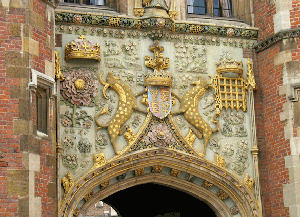Yale
Your first thought may be of the famous Yale University in the US, or perhaps of a make of cylinder lock. Neither is the sense that’s involved here, though there is a close link with two colleges of Britain’s Cambridge University and Yale does come into the story.
We are concerned here with mythical beasts. Classical and modern literature is full of them, ranging from centaurs and dragons to jabberwocks and Harry Potter’s blast-ended skrewts. This one is classical Roman, having first been described by Pliny the Elder. He gave it the name of eale — we don’t know why: the word turns up nowhere else in classical literature — and included it as an animal of Ethiopia:
It is the size of the river-horse, has the tail of the elephant, and is of a black or tawny colour. It has also the jaws of the wild boar, and horns that are moveable, and more than a cubit in length, so that, in fighting, it can employ them alternately, and vary their position by presenting them directly or obliquely, according as necessity may dictate.
The Natural History, by Pliny the Elder, circa 77 CE, translated by John Bostock. We know river-horse better by its ancient Greek name of hippopotamus. A cubit was a measure of length roughly that of the forearm, about 18 inches (44 cm).

The gatehouse of St John’s College, Cambridge, showing the arms of Margaret of Beaufort, with the two yales as supporters. (Photo: Peter M Eimon)
Nobody knows what animal Pliny was trying to describe. As so often, he may have been conflating inaccurate travellers’ tales about a number of different kinds of beasts, such as a type of big-horned African ox, an antelope or a species of goat. Following Pliny’s description, the yale is usually shown in illustrations as a mixture of bits of other animals, a chimera, with the snout of a wild boar, the body and head of an antelope, and a couple of long pointed horns of indeterminate origin.
The beast turns up in English heraldry in late medieval times, with its form borrowed from Pliny. By then its coat had changed to silver with gold spots. In herald-speak these are bezants, a name originally attached to gold coins minted in Byzantium. Because of the animal’s supposed skill in using its horns it came to represent proud defence. The connection with Cambridge University comes via Margaret of Beaufort, the mother of King Henry VII and reputedly the richest woman in medieval England. She founded two of the colleges of the university — Christ’s and St John’s — at the beginning of the sixteenth century. Because of this, her arms, including yales, may still be seen over the gatehouses of the two colleges.
Yale University has borrowed the heraldic beast as a play on its own name. Two in chains flank the portico of Davenport College, one is depicted on the official banner of the president of the university and the campus radio station uses a yale as a logo. The university was actually named in memory of Elihu Yale, a governor of the British East India Company. His name comes from Iâl, a place in north Wales, which in turn is from the Welsh word for a fertile or arable upland.
